That Fit Friend is supported by its readers. I [Jake Boly] run this site myself and buy the gear I review. If you purchase through my site, I may earn commissions on sales, read more here!
A new model drops, and we’re pressed with the tough question, “Do we upgrade or buy the old shoe and save?” Oftentimes, when a new iteration drops, we’ll see a steady price decrease, so I get hit with a ton of comments and DMs asking the above.
The Reebok Nano X5 dropped in early 2025, and we’re now seeing prices continue to plummet for the Nano X4. In prior years, it was a little more difficult to say whether you should upgrade or not because iterations like the X3 and X4 felt more like lateral moves versus shoes with clear differences between them.
This isn’t to say the Nano X4 was a bad shoe, but I do think in many ways it was a swing and a miss for a lot of athletes and lifters. It didn’t have that same versatile feeling that past Nanos had. It was almost as if it was trying to be a master of all, but ended up becoming a master of none.
I built this article to help lay out all of the key details that you should know when deciding between the Reebok Nano X4 and X5. Is newer better? I have my opinions on this and I’ll explain my rationale throughout my sizing, construction, and performance sections.
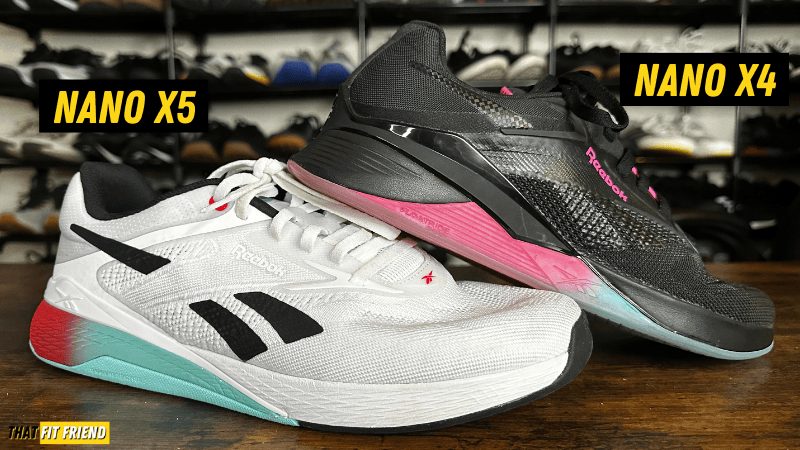
Quick Performance Takeaways
Performance Quick Notes
- Which Is Best for Lifting: Both can work great. From a midsole density context, the Nano X4 has a denser midsole. However, I don’t think that necessarily means its stability is that much better than the Nano X5. If your lifting is a little more dynamic, then I’d grab the X5, and for mostly static strength work, go X4.
- Which Is Best for CrossFit: Both can work great here, too, but I do think the Nano X5 is the stronger option. It feels a lot more versatile, which makes it a better contender for both heavy WODs and WODs with short runs programmed.
- Which Is Best for HIIT/Versatile Workouts? The Reebok Nano X5. The dual-response EVA midsole is WAY more comfortable and pliable for plyometrics, multidirectional work, and class-style sessions. If you’re primarily doing cross-training, cop the Nano X5.
- Which Is Best for Short Runs: Both can work for runs between 400-800 meters, but if you’re sending it between 1,000-1,600 meters, then you’ll be way better off in the Nano X5. It’s way more forgiving and its midsole is more comfortable for a variety of running styles.
- Which Is Best for Daily Wear: Reebok Nano X5. The reason I like the Nano X5 for daily wear is that its heel has a little more compression so its easier to wear for longer walks. Its toe box also feels better compared to the X4 and it has a less aggressive arch.
If you stop reading this article here, take my advice and grab the Nano X5 if you’re truly on the fence between them, and the price isn’t a factor in your buying decision. It’s a more well-rounded shoe for the gym, and it has a much better fit.

Reebok Nano X4
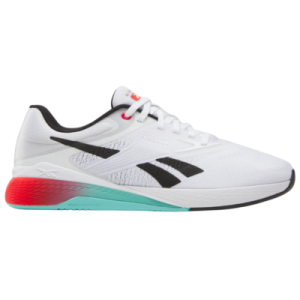
Reebok Nano X5
Sizing and Fit Thoughts
Narrow Foot Suggestions
- Reebok Nano X4: True to size.
- Reebok Nano X5: True to size.
Medium Foot Suggestions
- Reebok Nano X4: True to size.
- Reebok Nano X5: True to size.
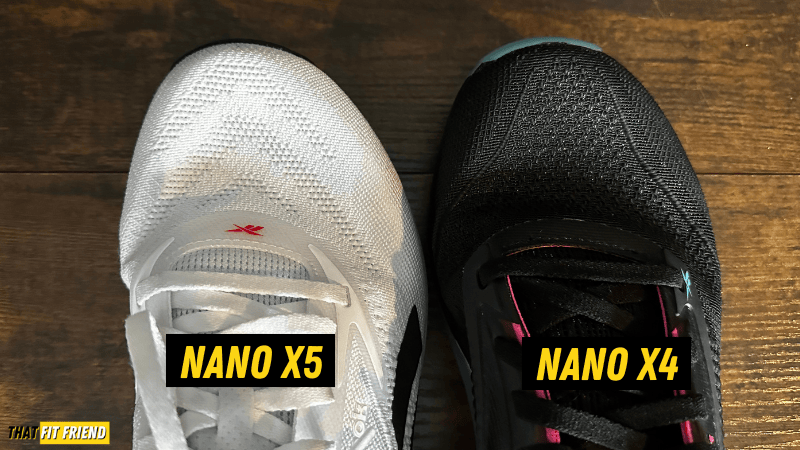
Wide Foot Suggestions
- Reebok Nano X4: E, true to size. EE+, pass or go up a half-size.
- Reebok Nano X5: E/EE true to size. 3E+, size up a half-size.
Flat Foot Thoughts: Both shoes have a fairly significant arch feeling. The Nano X4 is a lot more aggressive, though. If you have flatter feet, you may want to look into models like the Born Primitive Savage 1.
Performance Analysis
Lifting Showdown
From a baseline stability content, the Nano X4 is objectively denser with its midsole and “more stable” compared to the X5. However, I don’t think the slightly softer midsole in the X5 hinders its performance for lifting. I only noticed a difference when squatting anything over 315 lbs, and even then, it never hurt my performance.

Ironically, and this may be a first when comparing two shoes with different midsole feels, I actually prefer the X5 for lifting even though its softer. Its toe box feels better for toe splay so it’s easier to stabilize when squatting and deadlifting, and the softer feel leads to better toe grounding. The X4 had a fair amount of toe spring and with its denser ride, I always found it a little tough to fully ground the feet when training.
Outside of the toe box feel, the X5’s arch is also a little less aggressive. I have a normal arch, and it’s way more comfortable when stabilizing the feet, whereas the X4 can feel a little more jarring. You notice this most when doing longer leg days and doing workouts with cleans and snatches. It’s subtle, but if you’ve ever trained with both shoes, then I think you can pinpoint this feeling and will likely know what I’m talking about.
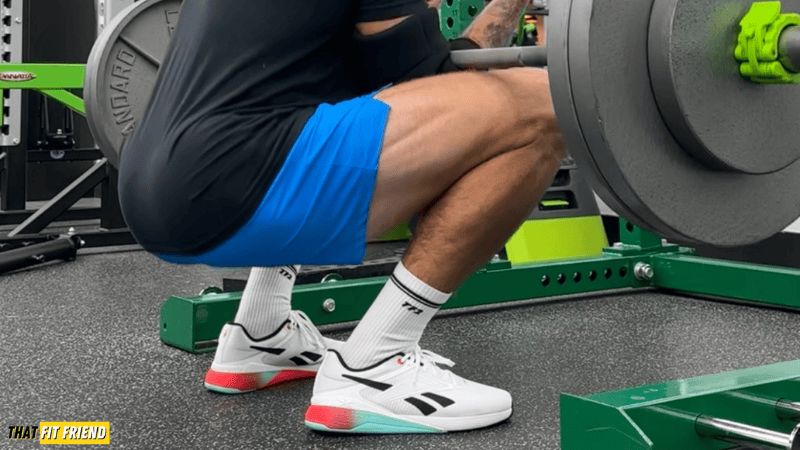
The grip for both of these shoes is solid, so I don’t think you should be concerned with grip on different surfaces. The final thing I’ll say about the X5 and why I like it more for lifting is that the split outsole and removal of the LAR system were good changes for strength training. They give the shoe a more flexibile feeling and it increases the ground feel ever so slightly in this model. The combination of these two changes scratches my itch for loving minimalist shoes for training.
CrossFit and Cross-Training Assessment
I’ll talk CrossFit first in this section. From a top-level down, the X4 and X5 have both held strong throughout my CrossFit tests. The X4’s durability has been solid for most WODs and the X5 has followed suit — and I’ve legit tried to purposely break both with high-volume rope climb and burpee workouts. The midsole and outsole lips and the upper materials have held strong thus far, which thank goodness, after the Nano X1 and X2 fiasco, I feel like this should the standard for Nanos.
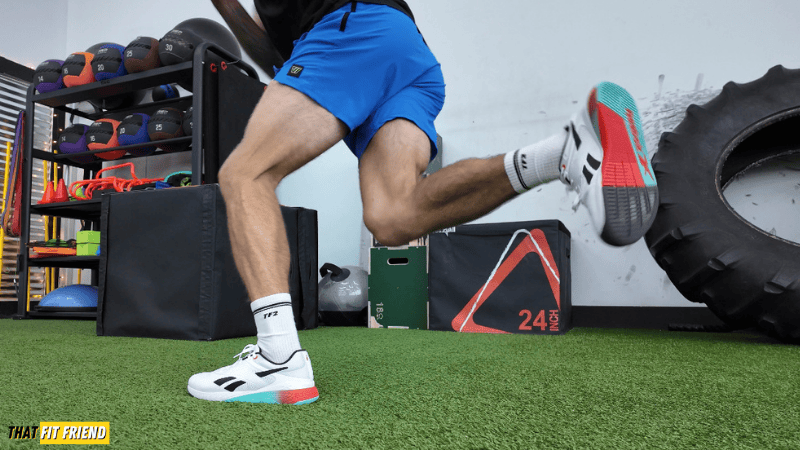
I think the main differences to consider when deciding between these shoes for CrossFit comes down to your foot and gym’s programming. If you like a lot of arch support and more rigid boot, then the Nano X4 will be the better fit for you. You’ll likely prefer how this shoe feels when doing things like burpee box jump overs and double-unders where you may want more support. For everyone else, I’d opt for the Nano X5.
It does a slightly better job of giving you a more comfortable ride for a wider range of WODs. If I program barbell cycling, rope climbs, burpees, or short interval runs, these feel better on the feet. The dual-response EVA is more repsonsive and “lively” which I personally love because it keeps these feeling comfortable for longer workouts, especially if you train later in the day and you’ve already been on your feet all day.

For cross-training, I bet you already know what I’m going to say. I’m taking the X5 here, too. The increased flexibility, better feeling midsole, and upper security have all been great. As an example, I do a lot of explosive lateral work and this shoe has done a good job with accommodating those training asks. I never have massive spillover issues and the grip is good on both turf and rubber gym floors, so if you take classes with multi-directional work, I wouldn’t stress slppage in this model.
If you take classes that involve a lot of jumps and short runs, that’s also where the X5 shines. You can see in my full review how the forefoot and heel have more bounce when pressing into them. From an energy return context, this has been a solid update over the X4, and they tend to break in a lot faster.
Short Runs and Casual Wear Tests
For running, neither model is going to be a hybrid workout star, however, the Nano X5 is taking the edge here as well. Now that said, if you’re only running 400-800 meters, then you’ll be fine in either shoe and I wouldn’t stress too much. Both shoes can also work for some sprints here and there if you’re not looking for something more minimalist and flexible.

I think the running bias comes into play for anyone who’s routinely taking classes with runs programmed and for those who like doing short runs before and after their workouts. The transition from heel to toe feels a lot smoother in the X5. Additionally, it’s also a better model for anyone who likes to add walking in post-workout. For example, if you like to program 20-30 minutes of incline treadmill walking post workout then you’ll be more comfortable in the Nano x5.
When it comes to all-day wear, I don’t necessarily love either of these shoes because their appearances don’t really have that gym/causal crossover vibe I like. If you want a gym shoe that you can dress up and train in, then I’d look into models like the STRIKE MVMNT Haze Trainer and Transit StreetTrainer.
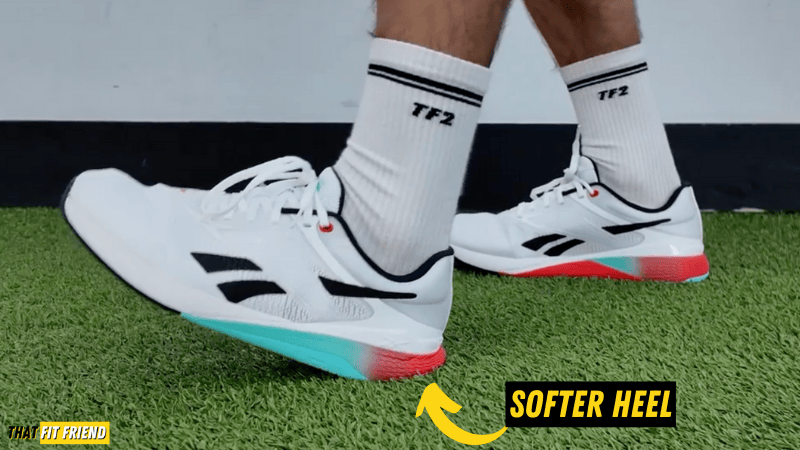
Outside of their appearance, the arch support is also a fit compont that I think hinders the X4 and X5’s all-day comfort. The higher drop and bulkier constructions feed into this as well. If you do plan to wear one of these all day, then you guessed it, the X5 will be the better option between these shoes.
Construction Details
Midsole
Similarities: The Nano X4 is built with Floatride Energy Foam and the Nano X5 has a dual-response EVA foam midsole. To the touch, the X4’s midsole is denser with less give and responsiveness. Both shoes have a similar stack height and a heel-to-toe drop that sits at 7mm.

Differences: The X5 has a break in the outsole and a varied tread which I actually think gives it a more flexible feeling and its grip is, dare I say it, a little better. There have also been changes to the RopePro wrap. The X5 is a little more rounded and less angled/sharp. I think this makes this shoe a little more grippy compared to the X4.
Outsole
Similarities: Both of these shoes feature rubber outsoles with small splits in the forefoot for additional flexibility and weight reduction. I have yet to have issues with either of these shoes from a durability or grip context.

Differences: The X5 has a break in the outsole and a varied tread which I actually think gives it a more flexible feeling and its grip is, dare I say it, a little better. There have also been changes to the RopePro wrap. The X5 is a little more rounded and less angled/sharp. I think this makes this shoe a little more grippy compared to the X4.
Upper
Similarities: Flexweave materials and textiles. Reebok generally uses similar lineups of materials in the Nano unless it’s a drastic change, like when they originally introduced the Flexweave in the Nano 7. The X4 and X5 both feature a Flexweave variant.

Differences: The X5’s Flexweave is more spacious regarding its volume, and the overlays have been reworked around the midfoot. The boot has also been changed and brought down slightly. If you had rub in the X4, then I don’t think you’ll experience that issue in this model. It feels a lot better from a security and comfort context, and the there’s only a small layer of TPU around the heel.
Laces and Tongue
Similarities: Both tongues feature a gusset and are built with a padded mesh material. They’re shorter and have two tongue loops for additional security. There are six eyelets with a similar lacing system on both shoes, too.

Differences: The one downfall of the Nano X5 is its tongue. It runs a little short and can feel a little awkward at times. This shouldn’t be a bother for most lifters and athletes, but for exceptionally low-volume feet, you may have issues with them.
Final Remarks
The Reebok Nano X4 and X5 are both good gym shoes, and for most, both will suffice just fine for lifting and cross-training. Don’t stress if you’re finding a sick deal on the X4 and want to rip those despite my sentiments towards the X5 in this comparison.
If you’re like me, though, and you want the most out of your shoes, I do think the X5 is the stronger option. It feels the best on the feet and it really hits the “generalist” and well-rounded performance verticals well. The Nano X4’s denser midsole and more aggressive arch are its biggest flaws and if you have wide and flat feet, then these are more reasons to opt for the X5.
If you have additional questions about these models or if you’re thinking of other options now, drop a comment below or reach out via Instagram!




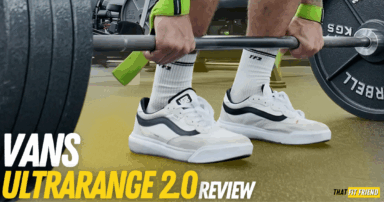

Anne Wood
I’m on the fence about the X5’s and was wondering if you knew how they would be for someone like me who overpronates. I currently have the Nano 9 and love it. I wear an insert with them and they have never bothered me. Thank you!
They should work, imo! Or at least…I’d give them a shot. They’ll feel lighter and more sporty than your 9, but width wise/fit, they should be okay compared to their two predecessors the X4/X3!